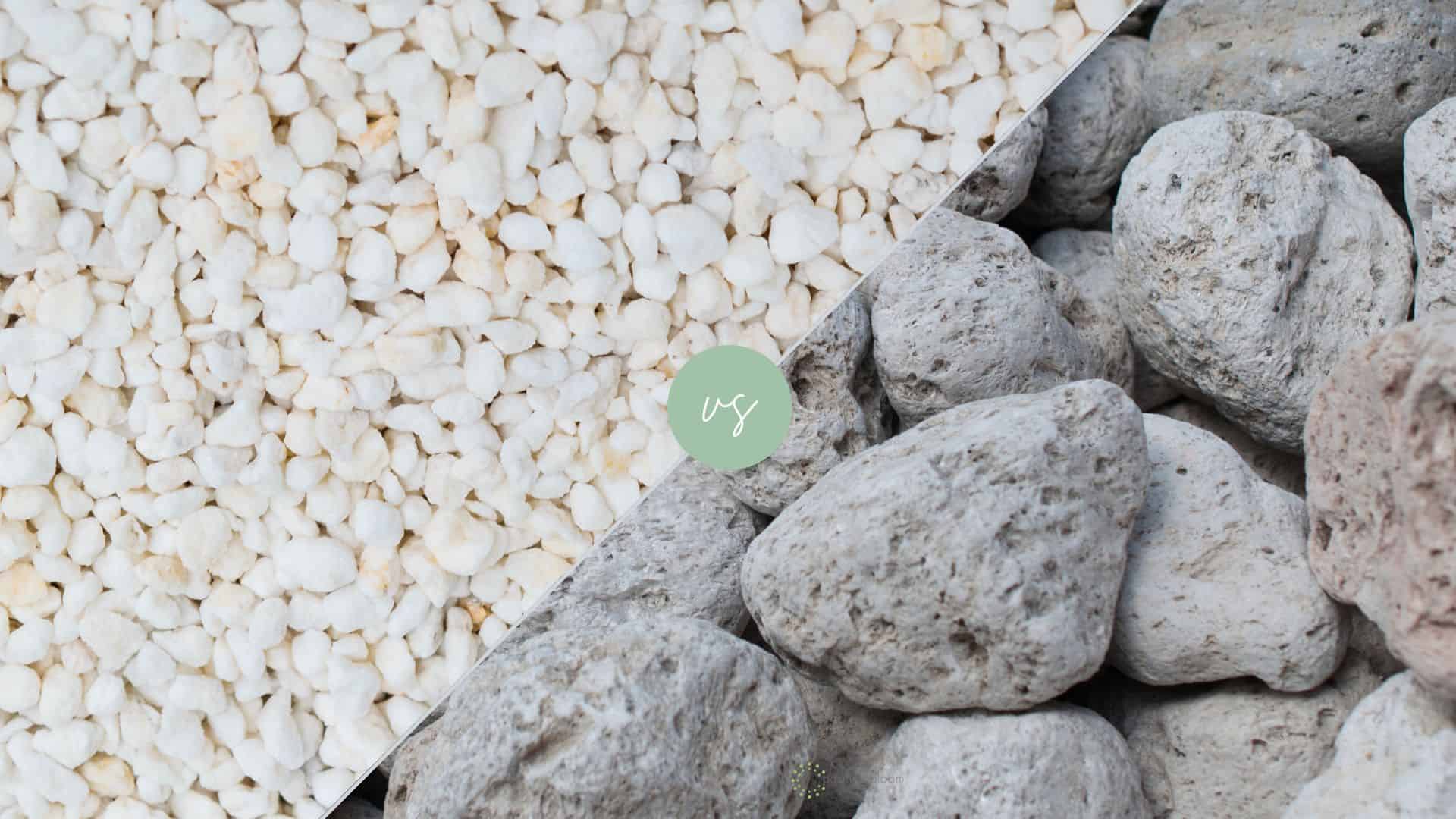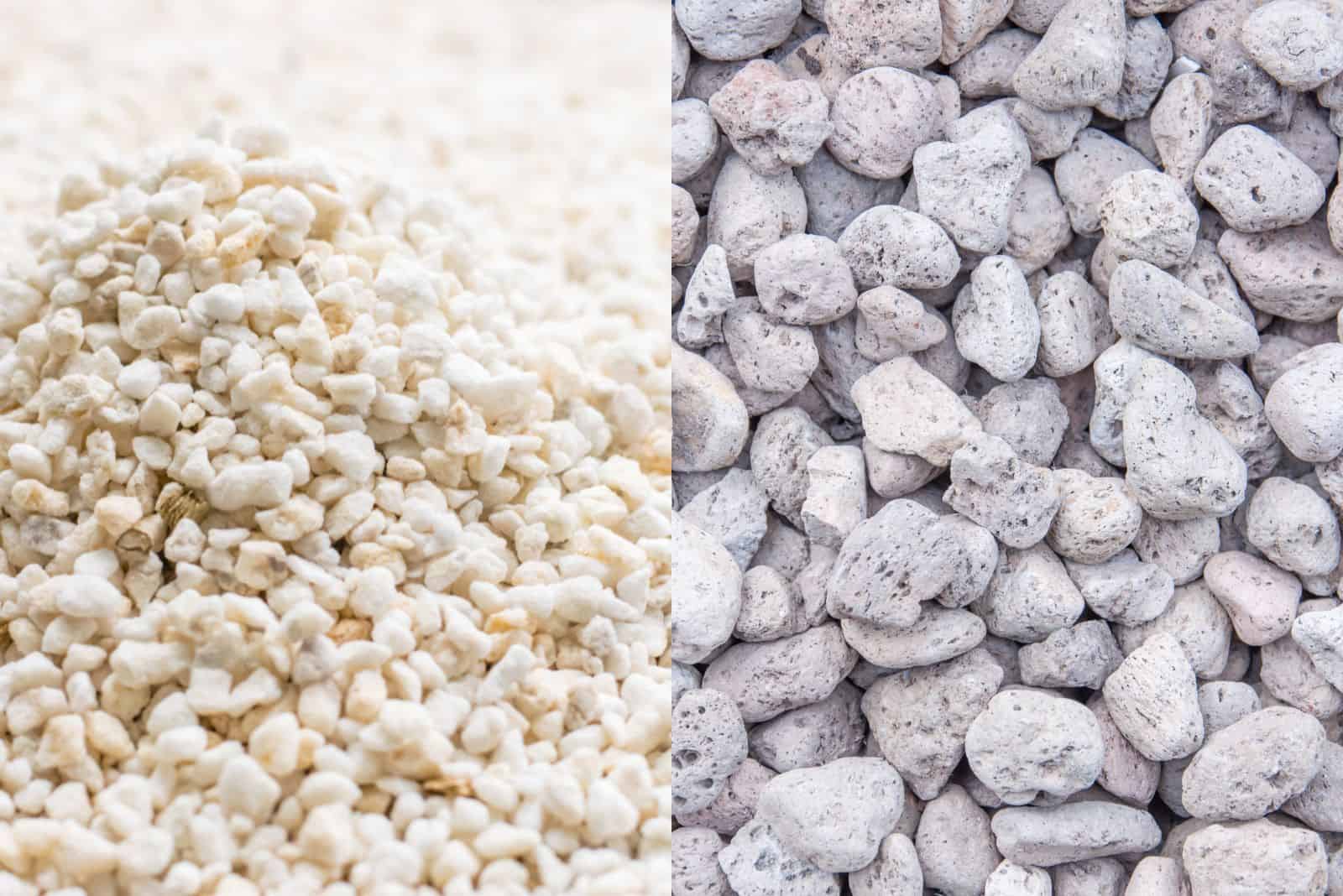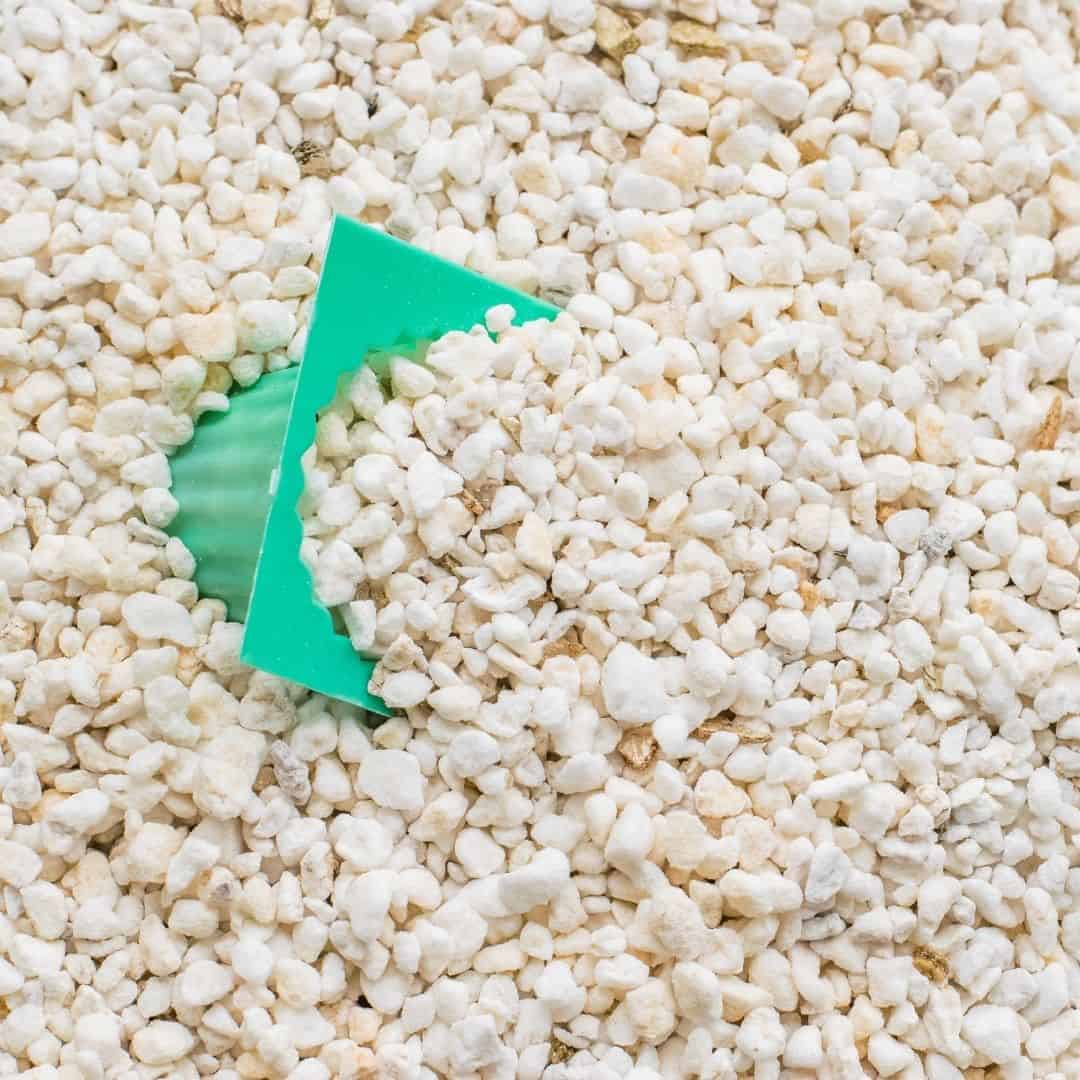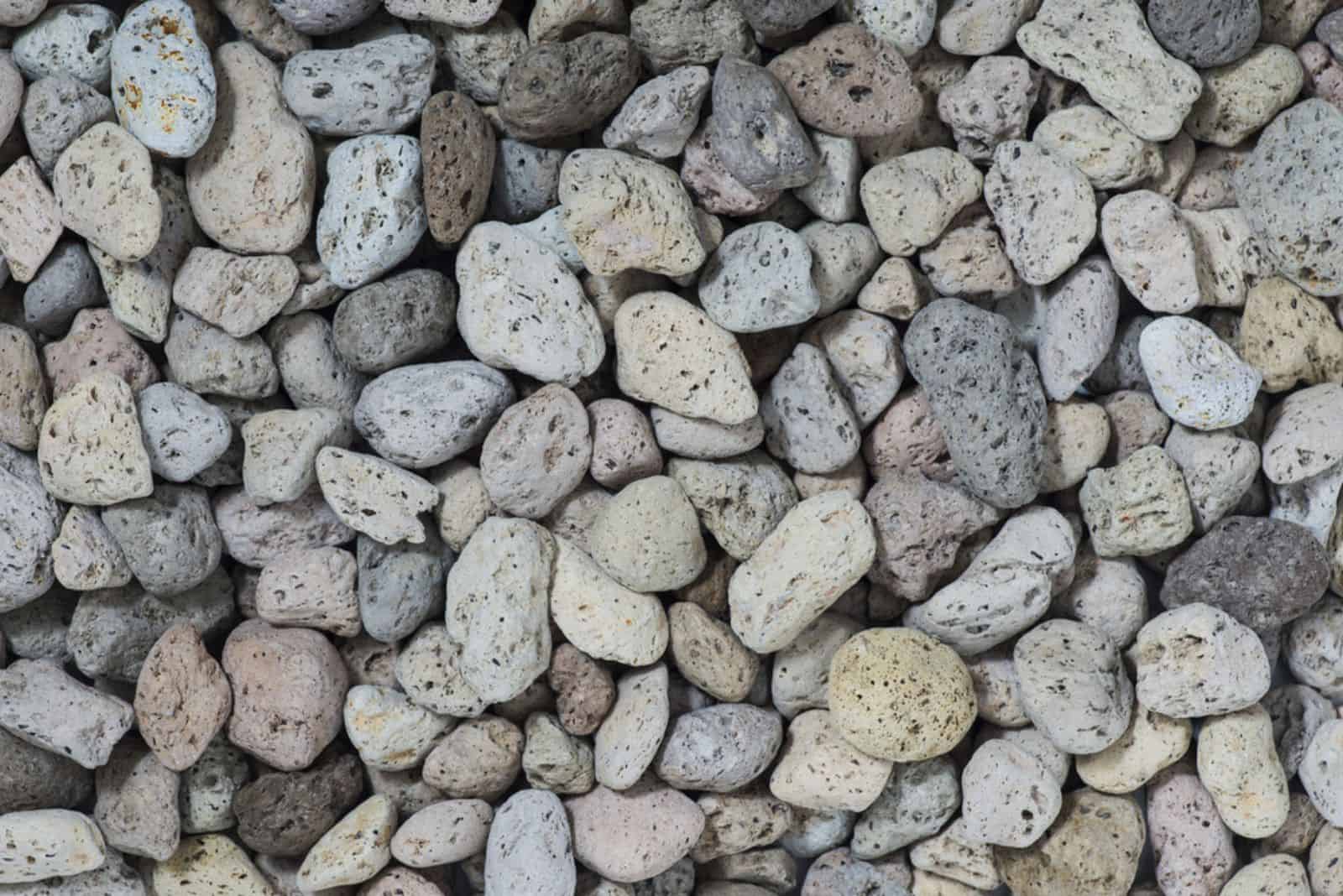Perlite and pumice are both formed during volcanic eruptions and have many applications in gardening, hydroponics, and even horticulture.
However, once we start examining their color, porosity, price, processing, origin, and environmental friendliness, we’ll notice how different they actually are.
But in terms of their use, it’s usually the same. They are both soil amendments we use to increase drainage and aeration, prevent compaction, etc.
And based on these factors, we can single out the advantages and disadvantages of each material so that you can decide which one is better for your plants.
Before we do that, let’s look at their basic characteristics:
[table id=625 /]
Perlite vs Pumice
Before we examine the differences between perlite vs pumice, such as color, origin, price, porosity, processing, and ecological friendliness, let’s find out what these materials actually are.
Perlite is a type of volcanic glass formed when lava cools rapidly. It has a unique structure composed of tiny, closed cells that contain a small amount of water.
When perlite is heated to a high temperature, the water inside the cells vaporizes, causing the cells to expand and create a lightweight, porous material.
Pumice, on the other hand, is a type of volcanic rock that forms when lava with high levels of gas bubbles cools down extremely rapidly.
Color
One of the primary things that helps us differentiate between pumice vs perlite is their color. Pumice is creamy white, although it can get gray or brown if exposed to plenty of sunlight.
Perlite, on the other hand, has more nuance. Unrefined perlite is usually gray, light, and sometimes almost transparent, although it can be gleaming black.
However, once we process it, it obtains that snowy white color, but it can be a bit grayer.
Place Of Mining
Pumice mining goes on all over the world, although most of it comes from Greece, Italy, Turkey, Iran, the USA (Arizona, Oregon), etc.
Perlite mines are also all around the globe, but when it comes to the U.S., they’re typically in Utah and Oregon. Other significant perlite suppliers are China, Italy, Turkey, Greece, Mexico, and the Philippines.
Porosity And Water Retention
The best cactus and succulent soil mixes contain perlite or pumice, but it is important to know how porous they are if we want to create perfect conditions for these plants.
One key difference between pumice and perlite is that pumice has a higher degree of porosity. This means that it has more small pores and a higher surface area, which makes it more effective at nutrient and moisture retention in soil.
Perlite, however, has a lower degree of porosity, which means it doesn’t retain water and minerals as well as pumice.
Composition
Pumice mainly consists of silicate minerals such as quartz and feldspar, although it contains mica and hornblende in smaller quantities.
The primary substance in perlite is silicon dioxide, but it also contains small amounts of potassium oxide, sodium oxide, iron oxide, and aluminum oxide.
Price
Perlite is less expensive than pumice, and you can find it in almost any nursery or garden center, as well as online.
Pumice stone, therefore, is more costly, and you can’t find it on every corner like perlite. This material comes in various sizes, so you can easily find large rocks for landscaping, but not the ones you need for amending potting or garden soil.
Luckily, you can order it online to help keep your potted plants healthy.
(The main difference in the prices of these two elements is due to the mine location and transport cost.)
Processing
Perlite has to go through a heating process in order for the water to evaporate and create the tiny rocks as we know them.
Unlike perlite, pumice doesn’t undergo any special processing after mining. After extracting it from the earth, pumice is typically cleaned and sorted to remove any impurities or debris.
Industrial Application
Although we use perlite and pumice interchangeably for plants, their uses differ in industrial applications.
For instance, we use both materials as lightweight aggregates for making concrete and plaster, as well as for insulation.
But we can also use perlite in filter aids, cryogenic insulation, and as a filler in paint, plastic, and rubber products.
Pumice is an abrasive material due to its rough surface texture, and we can find it in polishes, hand soaps, and other products that require an abrasive ingredient. We can also find pumice in personal care products such as scrubs and exfoliants.
Perlite vs Pumice: Similarities
Perlite and pumice are different in terms of where they come from and how they look, but when it comes to their uses and application, they’re virtually the same.
They’re far superior to other soil amendments (such as peat moss, coco coir, etc.) because they don’t decompose over time, provide better drainage and aeration to regular potting soils, etc.
Let’s find out more.
Eco-Friendliness
Both perlite and pumice are eco-friendly materials due to their natural origin and many uses in products that can help reduce energy consumption and emissions.
For instance, pumice can increase moisture retention and help reduce toxic runoff from sandy soils (which contaminates the surrounding substrate and the underground waters).
Furthermore, you can use perlite to insulate your home, which reduces heating and energy expenditure.
Finally, these two materials don’t disintegrate over time like organic products, so you won’t have to keep buying more and more to replenish the ones in your soil.
Application For Plants
We use perlite and pumice interchangeably, whether we need an ideal soil additive or a lightweight material in construction.
We use them for amending the structure of the substrate, in seed-starting mixes, and for rooting cuttings. They have drainage and aeration properties that prevent overwatering and root rot, allow the plant roots to grow freely, and provide air to beneficial microorganisms.
Growers use both materials as a top dressing, in landscaping, for fairy gardens, etc.
Increase Drainage And Aeration Of Potting Mixes
Pumice and perlite are porous materials, and we use them to prevent the soil from getting waterlogged.
They are an invaluable ingredient of any aroid potting mix because they increase drainage and aeration.
Therefore, they’ll allow the excess water to “flow” through the soil and out through the drainage holes, keeping the plant roots safe.
Prevent Compaction (Used As Soil Additives)
These soil amendments increase drainage and prevent soil compaction. For instance, you can switch them with sand, but you may end up creating muddy soil that gets packed tightly together whenever you water it if you don’t use the correct quantities.
Luckily, the interconnected pores in these materials create tiny channels through which the air and water can move.
Don’t Retain Much Moisture (Unlike Vermiculite)
Unlike vermiculite, perlite and pumice don’t retain too much water, which is why they’re an ideal soil additive for cactuses, succulents, bonsais, and seedlings.
However, they do hold some moisture, so you can use them to improve the soil structure of sandy soils.
They can also increase aeration, allowing the air to reach the plant roots and improve nutrient availability without the risk of getting waterlogged soil.
Both Last For A Long Time
Perlite and pumice are long-lasting materials because they don’t decompose over time when you add them to the soil.
Insects and pests cannot harm them, nor will they rust and corrode, which is why they’re perfect for use in horticulture and construction.
Finally, they’re resistant to environmental factors (they cannot be blown away that easily) and require little maintenance to keep their properties.
Neutral pH
Pumice and perlite have a neutral pH level (around 7), which has many benefits for plants.
• Most plants require slightly acidic to neutral pH for proper growth. Using one of these materials allows them to absorb the necessary nutrients from the soil without being hindered by too alkaline or acidic pH.
• A neutral pH level allows for more efficient fertilizer absorption in the soil.
• A neutral ph level creates the perfect environment for beneficial microorganisms to thrive.
Of course, since they are neutral in pH, pumice and perlite cannot change, but they can help maintain it in this state.
Pros And Cons Of Perlite
There are many benefits of using perlite:
• Perlite can enhance the structure of the soil because it improves drainage, aeration, and retains some moisture.
• It is eco-friendly.
• Perlite is a lightweight material and reduces the weight of the final product (which is essential in construction and industrial application).
• It is a long-lasting, doesn’t decay, and isn’t a subject to pest infestation.
• Perlite has a high degree of porosity and tolerates hot conditions, so it’s useful for various construction, industrial, and gardening applications.
• The neutral pH of perlite doesn’t affect that of the soil.
• It is cheaper and more widely available than pumice.
Of course, perlite has a couple of drawbacks:
• Perlite is dusty, so you should take measures of precaution so as not to inhale it.
• Due to its neutral pH, perlite isn’t the best choice for plants that prefer acidic growing mediums, as it doesn’t change the pH level of the soil.
Pros And Cons Of Pumice
Gardeners love pumice due to its many pros:
• It is environmentally friendly.
• Pumice enhances drainage and aeration, but still retains some moisture, making it perfect for heavy and sandy soils.
• It has a neutral pH, so it’s suitable for most plants.
• Pumice retains moisture and nutrients better than perlite and is a perfect growing medium for hydroponics.
• It is a great insulator due to its low heat conduction and density.
• High-quality pumice doesn’t contain dust.
Unfortunately, this material has some cons:
• It is more pricey and less available than perlite and other soil amendments.
• Pumice is not as long-lasting as perlite because it is relatively soft and brittle, wears down, crushes easily, etc.
• It isn’t suitable for heavy loads.
FAQ
How do I use pumice and perlite?
Mix equal amount of pumice and perlite (1 part in total) with 3 parts potting soil to enhance the drainage and aeration of the planting medium.
These materials are also suitable for top dressing bonsai, cactuses, and succulents. Sprinkle them on the surface of the growing medium and gently work them into the soil.
Many growers also mix these ingredients together and grow their drainage-loving plants in that blend. Finally, these inorganic materials are great for hydroponic gardening, as they’ll support the roots of your green buddies.
Can you grow plants in just pumice?
Yes, it is possible to grow plants in pumice alone, particularly those that prefer hydroponic mediums.
However, this is an inorganic material, so you’ll have to replenish nutrients all the time in order for your plants to flourish.
What is a cheap substitute for perlite?
Some cheap substitutes for perlite include sand, horticultural grit, gravel, pebbles, etc. But unlike perlite, different types of stones can be too large, so you might need more time to find the ones that fit your needs.
Also, there are specific sand types suitable for gardening, such as horticultural, builder’s, and river sand, so use them instead of beach or play sand, which will only compact the soil and lead to waterlogging.
Final Thoughts
The main difference between perlite vs pumice is their color. However, the price, processing, place of mining, porosity, composition, and industrial application can also help you distinguish between them and choose the one that fits your needs best.
Luckily, they have many similarities: they’re both long-lasting, eco-friendly, improve soil structure, and have a neutral pH.
We use them interchangeably for plants, but there are slight nuances, so we included the pros and cons of each material to help you decide which one to get.
Until next time!






